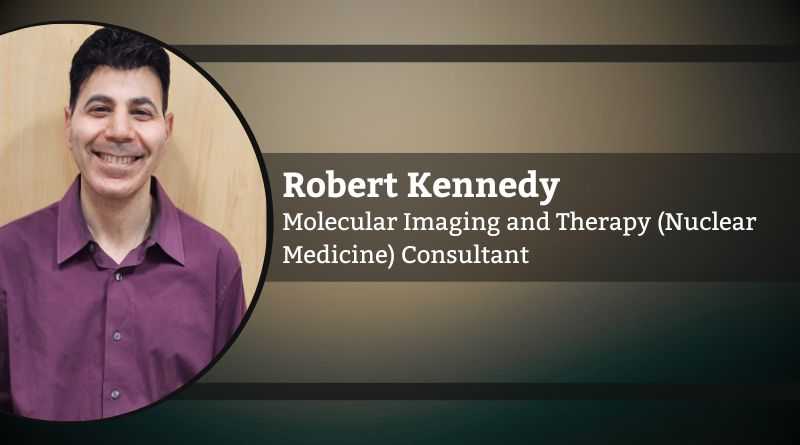Why have Radioligand (RLTs) or Radiopharmaceutical Therapies (RPT) become so popular in cancer treatment?
By Robert Kennedy, R.Ph, ANP, MBA Molecular Imaging and Therapy (Nuclear Medicine) Consultant
Nomenclature. First off, Radioligand (RLT) or Radiopharmaceutical therapy (RPT) are different names for the same thing. It is defined as the delivery of radioactive atoms to tumor-associated targets within the body’s cells. RLTs have several advantages as a novel treatment for cancer: unlike External Beam RadioTherapy (EBRT) or other forms of radiation, the radiation is not administered to the patient from outside the body, but rather it is injected inside the body. In contrast to chemotherapy, which destroys both the normal cells and the cancerous tumors, RLTs are targeted to the cancerous cells only with minimal adverse events or side effects. Due to RLTs targeted mechanism and radiation delivery, they are more efficacious. There are different radioisotopes (radioactive portion of an RLT) that can be utilized, along with varying ligands of targeting that are the second portion of the RLT. Namely, these are Beta particles or highly potent alpha particles. Many of the RLTs have an additional advantage in that they can be imaged under a Nuclear Medicine camera for precision and also to aid in the trials for FDA approval.
How do RLTs work? RLTs generally have 3 components: The radioisotope, which is the radioactive compound. The targeting molecule can also be called the ligand, small molecule, peptide, or monoclonal antibody. The Linker enables and ensures a stable attachment between both the radioisotope and the targeting molecule. Think of two train cars attached by a coupler between them. In the first train car is the radioisotope, the coupler that joins them is the linker and the second train car is the targeting molecule. All three work together to form the train and none can exist efficiently without the other.
How does the Radioisotope, linker, and targeting molecule work together to destroy the tumor? Well, the linker keeps the radioisotope and targeting molecule together, making it stable. The targeting molecule drags the radioisotope to the specific site of cancer and the radioisotope destroys the tumor with its radioactive payload. This is why the safety and efficacy are both high, due to the small number of healthy cells that get caught in the crossfire.
Diagnostic and RLTs have a bright future, especially in cancer care, by helping patients achieve remission through excellent efficacy and safety due to their targeted mechanisms.
What is another use for radiopharmaceuticals? Nuclear medicine, which utilizes radiopharmaceuticals, started in the 1950s with diagnostic imaging; the therapies already discussed came later. Perhaps their very vital function in the Nuclear medicine world is that of imaging cancers as well as other organs. Unlike a CT or an MRI, nuclear medicine images are dynamic, meaning they show blood flow, organs, function, and metabolism. This is a perfect counterpart to the RLTs already discussed in that you would image the cancer with a diagnostic radiopharmaceutical and then treat it with an RLT. Many RLTs have their own “pairs,” meaning the same or similar ligand (targeting molecule) will be linked to a different imaging radioisotope for imaging purposes. Most notable among these diagnostic radiopharmaceuticals are the PSMA radiopharmaceuticals for imaging and treating prostate cancer.
What are the types of Diagnostic radiopharmaceuticals and how do they differ from RLTs? There are two main types of diagnostic radiopharmaceuticals: SPECT images (Single photon emission computed tomography) that utilize low-level gamma photon radiation and PET (Positron emission tomography), which uses positron emission to allow a positron to interact with an ordinary electron, thereby causing the two particles to annihilate and two gamma rays in opposite directions to be the product. Both of these require imaging under a SPECT or PET nuclear medicine camera.
The difference between diagnostic radiopharmaceuticals and RLTs is the radioisotope and specifically, the energy it emits. SPECT and PET diagnostic radiopharmaceuticals have low-level radiation, mostly gamma, while RLTs use Beta or Alpha radiation, which delivers toxic payloads of radiation to cancer cells.
What types of cancer are Diagnostic radiopharmaceuticals and RLTs used for? Diagnostic radiopharmaceuticals are used for imaging: many types of cancer, including thyroid, heart (Nuclear stress test), liver, kidneys, blood flow, brain, bone, etc.
RLTs are used to treat: prostate cancer, neuroendocrine tumors, non-Hodgkin’s lymphoma, liver cancer, breast cancer, lung cancer, bone cancer, and many other solid tumors (note that some of the diseases mentioned involve RLTs still in development).
Next generation RLTs The next generation of RLTs will involve alpha radioisotopes, which are much more toxic to cancer cells than the existing Beta-radioactive substances. They also can be viewed as safer because they have a shorter range in tissue in comparison to beta, thereby sparing even more healthy cells and the bone marrow. Additionally, their radiation can be blocked by a piece of paper, making their handling and patient discharge easier after treatment. “Pan-cancer” approach therapies are in development as well. These RLTs use targeting molecules that attach themselves to an overexpressed cell present in multiple forms of cancers instead of just one, such as PSMA. This means one of these radiopharmaceuticals can be used to treat multiple forms of cancer.
Summary Diagnostic and RLTs have a bright future, especially in cancer care, by helping patients achieve remission through excellent efficacy and safety due to their targeted mechanisms. This will contribute to patients’ overall survival (OS) and progression-free survival (PFS) as well as their quality of life. This is exactly the reason that some RLTs are currently being evaluated for earlier lines of treatment ahead of chemotherapy as a standard of care.
Robert Kennedy, R.Ph, ANP, MBA Molecular Imaging and Therapy (Nuclear Medicine) Consultant.
rkennedy1113@gmail

